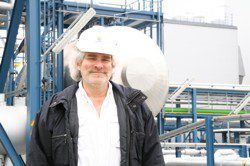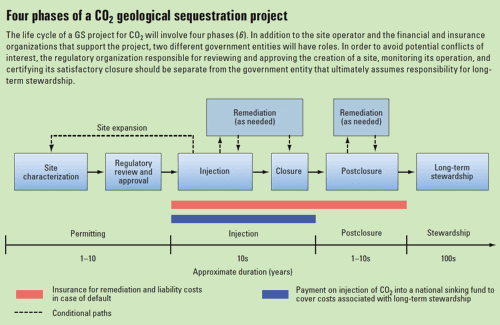
In my earlier post Schwarze Pumpe Part 1: First Operational CCS Plant Captures Carbon, Will it Lead to “Clean Coal”? I discussed a recent visit to Schwarze Pumpe in eastern Germany. Located in near the Polish border in Spremburg, Schwarze Pumpe is a pilot Carbon Capture and Storage plant built and operated by Swedish power utility Vattenfall.
Designed as a proof-of-concept project, the 30MW demonstration facility doesn’t contribute power to the grid, instead selling the steam it produces to a neighboring paper mill. Schwarze Pumpe does its job well, sufficiently proving that the Oxyfuel process of capturing carbon works and providing Vattenfall incentive to continue research and development in hopes of eventually bringing a 1000 megawatt commercial-scale coal-fired carbon capture and storage plant online by 2020.
But what about storage?
Along with capture comes, of course, storage. Capturing the carbon does little good if there is nowhere for it to go. And this is where we take up where we left off in the previous post.
Operating at full capacity, Schwarze Pumpe captures about nine metric tons of CO2 per hour. The storage tanks onsite can store 20 hours worth of CO2. At the end of the day, therefore, the stored CO2 must go somewhere. Three options are available:
- Piped to aging oil and gas fields for enhanced recovery (such as the Weyburn project Angelique mentions in her post from yesterday).
- Geologic storage (for Schwarze Pumpe this would be in saline aquifers, common in northern Germany).
- Trucked or piped offsite for use in other industrial applications (using the gas as a resource instead of a waste product).
To date, only one of those options is available to the engineers at Schwarze Pumpe – trucking the gas off for use in industrial applications. Unfortunately, this option is viable for only a fraction of the CO2 stored onsite. Much to the chagrin of both the engineers and their guests that cold, gray, German spring morning, we were told that much of the CO2 is simply vented into the atmosphere because there is nowhere else for it to go.
The irony of capturing CO2 merely to release it into the atmosphere a few hours later is telling of the challenge facing CCS as a workable solution in reducing global carbon emissions – finding a viable and scalable means of disposing of, using, or safely storing the carbon (other than, of course, simply venting it to the atmosphere).
For their part, the operators of the Schwarze Pumpe project make clear that their process works, and it is policy that hinders them moving forward in finding a solution to the problem of storage. Vattenfall public relations manager Lutz Picard emphasized that it wasn’t their technology holding things up, put the lack of a policy framework for geologic storage of carbon preventing them from moving to the next step. And as in all things involving regulating carbon or CO2, many thorny and difficult issues remain in developing that policy framework (pdf) from which projects such as Schwarze Pumpe – and the whole idea of CCS – can move forward. Issues such as liability, monitoring, and reliable long-term sequestration of CO2 lay at the core of the problem.

Nonetheless, Schwarze Pumpe is important if for nothing more than proving the “front end” technology of carbon capture, as John Russell, VP of technology for the Canadian firm Mantra Energy made clear in his explanation of their “ERC” process. Through ERC, CO2 is transformed into formic and oxalic acid, formate salts, and methanol, all used for a variety of industrial purposes. Russell said they are tracking the progress of projects such as Schwarze Pumpe closely, as such technology is essential in utilizing captured carbon as a valuable resource.
While many potential options exist for either the storage or subsequent use of captured CO2, sustainably developing any of them to sufficient scale remains a key issue. Vattenfall projects its first commercial-scale CCS plant coming online in 2020, the same year that most climate scientists say world carbon emissions must peak.
There remains some question, then, whether CCS technology can come online in time and at a scale sufficient to truly help reduce carbon emissions and avoid the worst-case scenarios of climate change in the coming decades – even if the present technological, policy, and economic hurdles are conquered (Vattenfall hopes to bring the operating cost of their CCS process below the price of an emissions allowance certificate traded through the EU Emissions Trading Scheme within the next three years – that target price rests at about 26 Euros per ton).
While I generally agree with Angelique in her post yesterday that we should “do the best we can” in developing carbon capture and storage technology. With long-term geologic CO2 sequestration especially, we find ourselves, I believe, in a situation with no wholly acceptable solutions. The consequences of the choices we make now will likely be realized for generations stretching into the far horizon of a distant future.
We’ve already cooked the goose and are left with choices that are problematic at best.
The worst choice is certainly to do nothing, to continue with business as usual.
The myth of clean coal
The idea of “clean coal” is likely a false notion, especially when considering the complete life-cycle of coal power. But even the most optimistic and visionary among us must concede that coal power is not going away soon enough. We can’t simply wish it away, and so we are left with no better choice than to pursue the myth. It is important to realize, then, for what it is, an imperfect and incomplete solution that will, if we are diligent, honest, and perhaps lucky, lead us to a new energy economy.

e


